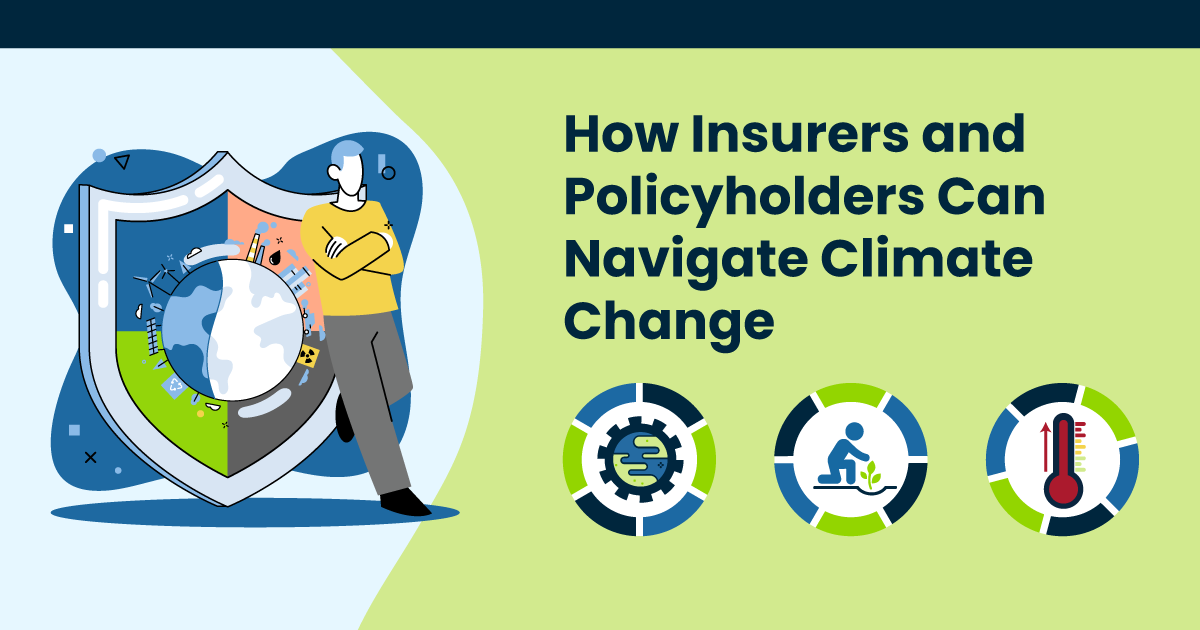
How Insurers and Policyholders Can Navigate Climate Change
Climate change is here, and it may already be making natural disasters like hurricanes and wildfires worse. As we’ve explained in a previous article, the coming years may bring even more frequent and severe catastrophes. The insurance industry must be prepared to navigate with better risk modeling, new insurance products, hardening measures and a proactive stance.
Better Risk Modeling
Climate change means that old risk models may no longer be accurate. FEMA1 and the National Flood Insurance Program recently rolled out Risk Rating 2.0, a new pricing methodology. According to FEMA, this is a “transformational leap forward” and incorporates more flooding variables to provide fairer pricing.
Other organizations have also been working on new risk models. First Street Foundation2 provides property-level information that is available to the public through Risk Factor. Currently, anyone can enter an address and see a rating on flood, fire and heat risks. The information includes historic events as well as current and future risk forecasts.
Including information on future risks is essential. According to Swiss Re3, models have traditionally been based on historical data. However, to achieve sustainable underwriting in light of climate change, insurers need models that also reflect present conditions and developments that are likely in the future.
New Insurance Solutions
McKinsey & Company4 says that the property and casualty insurance industry has largely underestimated the immediacy of the problem, and business models will need to adapt. As catastrophes become more frequent, traditional insurance products may become unaffordable for policyholders and unfeasible for insurers, so new solutions are needed.
One possible solution could come in the form of parametric insurance. Unlike other insurance products, parametric insurance pays claims based on the event itself rather than the actual losses. Also called index-based insurance, parametric insurance provides simple coverage and prompt payment. Although they are not generally considered to be suitable replacements for traditional policies, parametric policies can be used to supplement more traditional insurance policies and help policyholders deal with the immediate impact of a disaster.
According to World Resources Institute5, governments in developing countries have been experimenting with parametric insurance for natural disasters for more than a decade. In the U.S., adoption has been slow. However, Marsh McLennan6 reports that the demand for parametric insurance will become more mainstream as climate-related weather events become more severe and unpredictable. Since parametric insurance can be used to cover both specific catastrophic losses and frequency losses, it would be especially useful in business interruption situations caused by weather events like a hurricane. As Guidewire7 explains, parametric insurance allows insurers to not only mitigate risk, but also streamline its response to a catastrophe by automating payments that could otherwise overwhelm capacity from the sheer volume of filed claims.
Hardening Measures
In addition to covering losses from climate-related disasters, insurers may be able to help policyholders reduce their risks with hardening measures.
In wildfire-prone California, CalMatters8 says that Insurance Commissioner Ricardo Lara supported a bill that would have required insurers to renew policies for homes if the homes met the state’s standards for hardening against wildfire. The insurance industry opposed the bill, which died in committee. More recently, CalMatters9 says that the California Department of Insurance has proposed requiring insurers to take wildfire prevention measures into account when setting premiums.
Whether or not these proposals succeed, they raise the possibility of hardening measures becoming more important in insurance underwriting. Currently, something similar is happening in cyber insurance, where the recent surge in cyber losses has triggered rising rates and reduced underwriting capacity. According to CIAB10, cyber insurance underwriters are requiring certain cybersecurity protocols, such as multifactor authentication, to be in place. As natural disasters cause more property losses, it’s reasonable that insurers will require policyholders to be proactive against those risks, as well.
Acting Against Climate Change
The Intergovernmental Panel on Climate Action (IPCC)11 says that rapid and deep reductions in greenhouse gas emissions are needed to stabilize the climate.
As losses from natural disasters mount, insurers will need to find new ways to provide coverage and help policyholder manage their risks. And the industry just may have an even bigger role to play. An article in Property Casualty 36012 warns that insurers will see increasing pressure to move away from focusing on traditional risk transfer to taking a more proactive role in addressing the sources of climate change, specifically with regard to carbon emission reduction.
According to McKinsey & Company4, some property and casualty insurers are starting to incorporate climate-risk considerations into their underwriting process, while others have committed to reducing their exposure to carbon-intensive industries. Forrester7 predicts that usage-based insurance (UBI), which rewards insureds for driving less, could account for 20% of all auto policies by 2024.
Many businesses have begun focusing on Environmental, Social and Governance (ESG) issues. Celent13 asserts that the insurance industry should offer “innovative, sustainable, and technology-driven solutions” to address climate change challenges. Actions may include reducing underwriting capacity for fossil fuels while offering new products for environmentally friendly and sustainable technologies.
One Inc Can Help
In a time of crisis, One Inc understands the challenges insurers and their customers face. After a disaster, insurers need to get money to their policyholders in real need, in real-time. Fire, wind, hail, and water can all wreak havoc quickly. We help you deliver fast and secure claim payments to your insureds via their preferred payment method and channel, no matter the situation. One Inc helps you get your customers back on their feet as quickly as possible.
Sources:
- https://www.fema.gov/flood-insurance/risk-rating
- https://firststreet.org/
- https://www.swissre.com/institute/research/sonar/sonar2021/insurance-modelling.html
- https://www.mckinsey.com/industries/financial-services/our-insights/climate-change-and-p-and-c-insurance-the-threat-and-opportunity
- https://www.wri.org/insights/importing-good-idea-us-parametric-insurance-and-climate-related-risks
- https://www.marshmclennan.com/insights/publications/2018/dec/parametric-insurance-tool-to-increase-climate-resilience.html
- https://www.guidewire.com/blog/industry-trends/the-climate-crisis-hits-code-red-3-urgent-action-items-for-p-and-c-insurers/
- https://calmatters.org/environment/california-wildfires/2020/12/homeowners-insurers-fire-science/
- https://calmatters.org/economy/2022/05/fire-insurance-rules/
- https://www.ciab.com/resources/q1-p-c-market-survey-2022/
- https://news.un.org/en/story/2021/08/1097362
- https://www.propertycasualty360.com/2021/06/29/climate-risk-puts-insurers-on-the-hot-seat/
- https://www.celent.com/insights/781417323
Tags: Digital Payments, Climate Change

Written by The One Inc Content Team
The One Inc Content Team strives to provide valuable insights about digital trends and payments innovation for the insurance community.
Want to read more articles like this?

